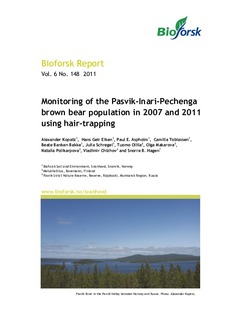| dc.contributor.author | Kopatz, Alexander | |
| dc.contributor.author | Eiken, Hans Geir | |
| dc.contributor.author | Aspholm, Paul Eric | |
| dc.contributor.author | Tobiassen, Camilla | |
| dc.contributor.author | Bakke, Beate Banken | |
| dc.contributor.author | Schregel, Julia | |
| dc.contributor.author | Ollila, Tuomo | |
| dc.contributor.author | Makarova, Olga | |
| dc.contributor.author | Polikarpova, Natalia | |
| dc.contributor.author | Chizhov, Vladimir | |
| dc.contributor.author | Hagen, Snorre | |
| dc.coverage.spatial | Norway, Finland, Russia, Kautokeino (NO), Inari (FI), Pechenga (RU) | nb_NO |
| dc.date.accessioned | 2017-10-14T21:45:55Z | |
| dc.date.available | 2017-10-14T21:45:55Z | |
| dc.date.created | 2017-09-29T19:30:00Z | |
| dc.date.issued | 2011-12-22 | |
| dc.identifier.isbn | 978-82-17-00874-3 | |
| dc.identifier.uri | http://hdl.handle.net/11250/2460174 | |
| dc.description.abstract | The trans-border brown bear population of Pasvik-Inari-Pechenga (Norway-Finland-Russia) has been monitored using genetic analyses of feces collection since 2005. In addition in 2007, hair traps were systematically placed out in the area to collect hairs for genetic analysis, to more precisely determine the minimum numbers of bears. In 2011, we repeated this hair trap study, using the exact same methodology as in 2007, to make a direct comparison of the results from the two years. Brown bear DNA was detected in 68 of 88 hair samples (77%) obtained from hair traps in 2011 and for 56 of these samples, a complete DNA profile could be determined. We identified 20 different bears in 2011, 12 females and 8 males. Only one bear was found in more than one country (Norway and Russia). We detected 11 bears in Norway, 7 bears in Finland and 3 bears in Russia in 2011. Four of these 20 bears were previously unknown, all four from Finland. A comparison of the results from 2007 and 2011 showed that we detected fewer bears in hair traps in 2011 (20 bears) than in 2007 (24 bears), but this modest difference may be coincidental. However, we observed a large drop in the yield of hair samples in the traps in 2011 compared to 2007 (88 versus 196 samples). This observation may be suggestive of some reduced activity of bears within the study area in 2011. In addition, only five (21%) of the bears caught in hair traps in 2007 were recaptured in 2011, which indicates a substantial turnover of individuals and may indicate that more frequent hair trapping monitoring would be beneficial to reliably track changes in the population. Additional samples (mainly scats) collected opportunistically in the field within the Russian and Finnish parts of the study area in 2011 detected four male bears in the Finnish part that had not been detected by hair traps. No additional samples from Norway were included to this study and any comparisons between the hair-trapping and opportunistic sampling at this point remains difficult. However, the results indicate that both methods combined are currently the most feasible methods to monitor brown bear numbers in an area. | nb_NO |
| dc.language.iso | eng | nb_NO |
| dc.publisher | Bioforsk | nb_NO |
| dc.relation.ispartof | Bioforsk Rapport | |
| dc.relation.ispartofseries | Bioforsk rapport;6(148) 2011 | |
| dc.subject | Hårfeller | nb_NO |
| dc.subject | Hair snares | nb_NO |
| dc.subject | Brunbjørn | nb_NO |
| dc.subject | Brown bear | nb_NO |
| dc.subject | Bestandsovervåkning | nb_NO |
| dc.subject | Population Monitoring | nb_NO |
| dc.subject | Molekylær økologi | nb_NO |
| dc.subject | Molecular ecology | nb_NO |
| dc.title | Monitoring of the Pasvik-Inari-Pechenga brown bear population in 2007 and 2011 using hair-trapping | nb_NO |
| dc.type | Research report | nb_NO |
| dc.description.version | publishedVersion | nb_NO |
| dc.subject.nsi | VDP::Naturressursforvaltning: 914 | nb_NO |
| dc.subject.nsi | VDP::Natural resource management: 914 | nb_NO |
| dc.source.pagenumber | 27 | nb_NO |
| dc.source.volume | 6 | nb_NO |
| dc.source.issue | 148 | nb_NO |
| dc.identifier.cristin | 1500677 | |
| dc.relation.project | Bioforsk: 8129 | nb_NO |
| cristin.ispublished | true | |
| cristin.fulltext | original | |
